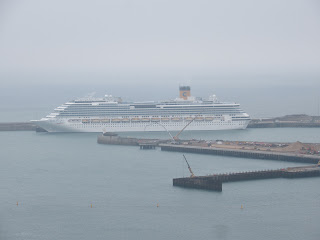I had chosen perhaps the worse day weather wise to visit Dover Castle. A view from the top of the castle which dominates the town and the port. It is one of the top castles in the country with loads of history and lots to see and free parking within the castle grounds.
Another view of the port and there is a ship in the distance but it is obscured by the fog.
But the weather cleared and I could see one of the many ferries that connect UK to France and Belgium...
...and the ship that you can't see in the photo above later in the day when the sun had burnt off one of the fog.
The castle sits in a commanding position on the top of the cliffs. The position has been popular for centuries. The oldest building surviving on site is the Roman lighthouse seen below which is now flanked by St Marys in Castro church.
A general view of the lighthouse and the church.
When William the Conqueror won the Battle of Hastings in 1066, he sent troops to Winchester to secure the Treasury and marched to Dover to secure his rear and access to France before marching on London. He built a motte and bailey here before moving on. The grand central keep seen below was started by Henry II in 1180's.
Entrance from the outer to the inner bailey.view of the inner bailey walls and entrance to the grand keep.
The entrance to the keep.
A view from the top of the keep of St Mary's and the Roman lighthouse.
There is a lot to see in the castle and visitor's should plan to spend all day here. However the interiors are lit as they may have been when the castle was occupied and few of the photos of the inside are clear but some were such as this view of a corridor beneath a spur casement with cannons pointing both ways.
One of the later fortifications added over the years as defences developed to counter advances in weaponry. There are more than six kilometres of tunnels under the castle, the oldest being medieval but there are three layers of tunnels under the cliffs, the middle layer built in Napoleonic times, 1797 to 1810, the upper layers built as a hospital in 1941 and the bottom layer, nicknamed Droopy in the Second World War...but photos underground are forbidden.A view of the kitchens at the base of the keep.
A catapult reproduction in the castle grounds.















No comments:
Post a Comment